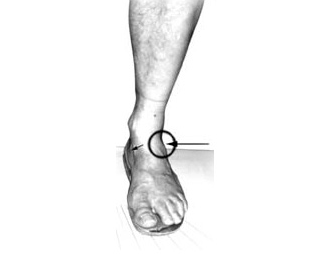Offset Design for reduces the burden on the knee
Offset center design to reduce the burden on the body. It is said that when we stand barefoot on the ground, we will stand with toes outward in a stable. It is same also on the slope. How about standing with ski boots? Usually when we stand with ski boots on the skis, we will stand with toes outward a little. So, we must rotate the knee inward constantly in order to make skis in parallel stance. Such a symptom was a corollary on human foot skeleton, physiology and ski boots design.
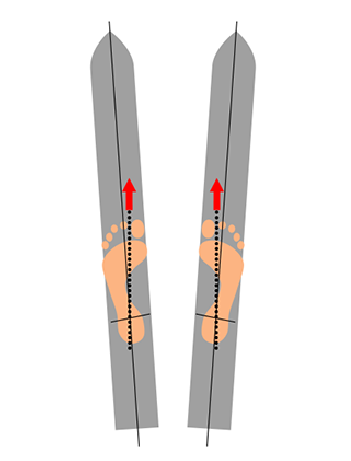
The traditional ski technique which rotates the legs has no problem for the characteristic of such ski boots, because the turn of ski by traditional ski technique was by rotation the knee. But such a performance of ski boots makes a disadvantage for the advanced ski technique. On the latest ski technique, the direction of ski is determined by leaning legs with both feet load in order to turn using effectively side curve of ski. In such a skiing, the knee flex into the inside leads to power loss. And it creates heavy stress on the knees and legs by large resistance from snow surface. It is important for ski boots that the knee flex is same direction as skis.
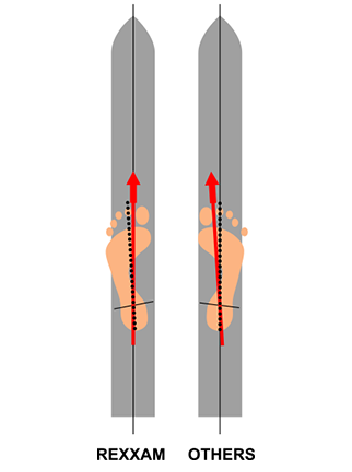
The last shape which embodies the ideal of schumaister
Rexxam ski boots, which are designed so that the knees enter straight when leaning forward, use an offset last that creates a natural state for the feet in the boots. The last is designed so that the center line of the foot faces outward with respect to the center of the heel, which is the load point. In other words, it creates the situation in ski boots that the toe is facing outward slightly when standing naturally. It is easy to make the skis parallel naturally just on wearing ski boots and to straighten the direction of knee flex. And as the front of knee receives the resistance from snow surface, the stress on legs is reduced for a long-time skiing.
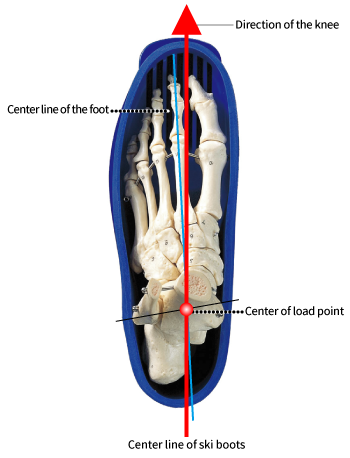
The last shape that embodies the ideal of schumaister.
In the development of ski boots, REXXAM has conducted joint research with schumaister in Austria as the home of shoes and completed A-One Concept. REXXAM has completed A-ONE CONCEPT in collaboration with Austrian schumaister in the development of ski boots.
They said that 90% of ski boots must be reworked. That’s means it is the necessary adjustment to put the foot correctly in ski boots and do a comfortable movement without disturbing the physiology of foot. It effectively locks the foot to move and improves the unnecessary pressure which leads to foot problem.
The ideal last design which was derived from many years of experience as schumaister has incorporated into REXXAM for every minor change. A-One Concept is new last design which was born as the culmination of result. That is the ski boots which embody the thought of Schumaister considering the health of foot.
Oblique shape of toe that emphasizes the natural shape of foot
The shape of human foot is divided into the following three. The most common shape is Egypt type in about 70% that first finger is the longest. About 25% is Greece type that second finger is longer than first finger. About 5% Square type that finger length is almost same and is called as the most appropriate foot for ballerina. But the most toe shape of ski boots is semicircular for top priority of design for fashionability and productivity. It doesn’t fit human foot. The adjustment in 80% on tune-up of ski boots is the base of big and little toe. It would not be an exaggeration to say that the traditional ski boots were the design which ignored the foot shape of human.
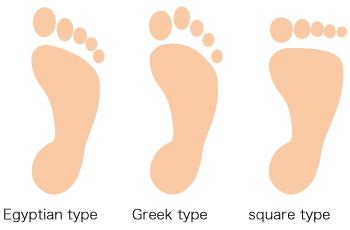
When wearing tight shoe of toe, our parallel sense is dull.
When even athletes with high exercise capacity tightly bandage their toe, they can’t walk the balance beam to cross over easily in an ordinary way. Let alone on skiing, in a state which the toe is strongly pressed inside, the direction of knee flex is not straight and it has negative effects for skiing. And also, hallux valgus which women especially note as foot problem is caused by the mismatch of toe shape of shoe and foot.
In addition, according to the analysis of process for hallux valgus, it can sometimes be to hallux valgus from broad foot. As side arch of sole is low in broad foot, big toe tries to spread (varus). But as big toe can’t spread on wearing shoes, it is bent to the center direction of foot on the joint part (valgus) and becomes hallux valgus. In any case, if the shoes toe box is tight, there is a risk that leads to foot problem.
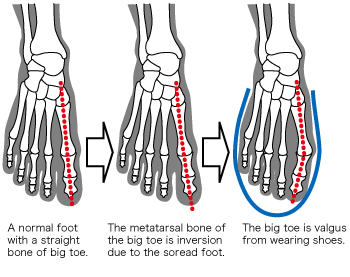
The last design of A-One Concept is the shape with an emphasis on human foot. REXXAM has applied the idea of prominent anatomist Meyer in 19th century to ski boots which emphasizes functional line of foot connecting center line of heel and big toe. This advantage is to lengthen big toe straightly. REXXAM designed the basic last which assumed Meyer line to cross the lines connecting the two points on the inside of heel and big toe base and connecting toe top. REXXAM realizes ski boots which can stick big and little toe out and is easy to take the balance during exercise.
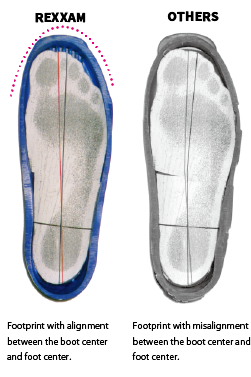
The heel peak is set high to improve hold ability.
The deep heel pocket design which gives a better fitting for the most important heel part in the ski boots.
By designing high peak position of heel, it is possible to keep the correct position for calcaneus, talus and ankle joint and to do knee flex correctly. Achilles tendon which does an important work in order to keep body balance constant in forward lean movement on skiing is the most sensitive part.
The excessive pressure leads to damage to achilles tendon itself. The peak position of heel prevents this pressure and numbness of foot.
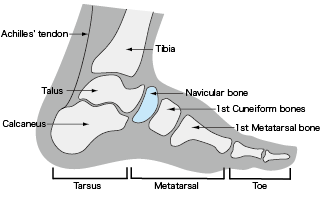
Keep the correct position for malleolus joint
Malleolus outside of talus is the joint which connects talus and tibia. So, if talus as a base of malleolus joint is compressed from outside by shell, malleolus moves to the inside and it means to put a big stress on knee. Moreover, it interferes with the correct skiing. In order to keep malleolus joint to the correct position, it puts flexibility into outside part of talus and reduces the stress to knee and makes possible easy skiing.
Design of navicular to make possible good fitting for dorsum of foot
The upper part of navicular contains many large blood vessels. So, if this part is compressed, the whole foot goes numb and it leads to reduce the sole feeling and exercise ability. Moreover, poor blood circulation to toe leads to cold toe. The design which puts flexibility into the part of navicular reduces the stress around dorsum of foot and prevents to go numb and cold toe.
